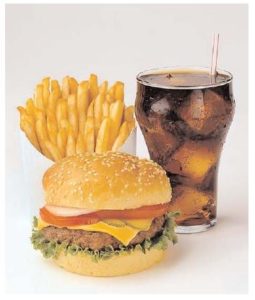 Emulsifiers are in many of the processed foods we buy. They are added to the foods to enhance texture and extend shelf life. Animal and human studies find that some emulsifiers (e.g., soy lecithin, carrageenan, polysorbate-80) can promote gut inflammation and alter the gut microbiome in a negative or harmful way. Recent research adds to this list the common emulsifier carboxymethylcellulose (CMC), also known as cellulose gum.
Emulsifiers are in many of the processed foods we buy. They are added to the foods to enhance texture and extend shelf life. Animal and human studies find that some emulsifiers (e.g., soy lecithin, carrageenan, polysorbate-80) can promote gut inflammation and alter the gut microbiome in a negative or harmful way. Recent research adds to this list the common emulsifier carboxymethylcellulose (CMC), also known as cellulose gum.
A small study randomly assigned 16 healthy adults to either an emulsifier-free diet or an identical diet with added 15 g per day of CMC for 11 days. No one knew what diet they were eating, and for those 11 days the participants were inpatient - thus no chance for cheating or altering the diet. Extensive testing (even biopsies on day 1 and 11!) was done before, during, and after the study. The Univ. of Pennsylvania researchers found that CMC resulted in several harmful changes, including a negative effect on the gut microbiome (microbial community of bacteria, viruses, fungi).
Results: The researchers found that CMC increased abdominal discomfort after meals, disturbed the gut microbial community and reduced its diversity (not good!). It resulted in reductions of short-chain fatty acids and free amino acids (thus impacted how nutrients are absorbed). One of the beneficial microbes associated with good health, and that was reduced in number was Faecalibacterium prausnitzii.
Two of the subjects who had CMC in their foods had increased microbial "encroachment into the normally sterile inner mucus layer" of the gut, which is a central feature of chronic inflammation diseases (e.g., IBD, type 2 diabetes). They also had large "alterations in microbiota composition". This means that there is variation in how people respond to the emulsifier CMC, with some people more sensitive than others.
The scary part is that the intestinal changes happened after just 11 days with a daily intake of 15 g of CMC - a dose that is approximately the total emulsifier consumption for a person whose diet is largely highly processed food. Yes, that is many of us eating a Western style diet (e.g., highly processed foods, and low in fiber, fresh fruits, vegetables, and whole grains). The scientists believe that long-term consumption of emulsifiers, because they result in gut microbial disruption and inflammation, are contributing to chronic diseases.
Bottom line: Read the ingredients list on food labels. Try to avoid foods that have ingredients listed that you wouldn't normally have in your kitchen. That means soy lecithin, CMC, cellulose gum, carrageenan, artificial colors. Even "natural flavors" (which are laboratory concoctions) should be avoided as much as possible.
From Medical Xpress: Ubiquitous food additive alters human microbiota and intestinal environment
New clinical research indicates that a widely used food additive, carboxymethylcellulose, alters the intestinal environment of healthy persons, perturbing levels of beneficial bacteria and nutrients. These findings, published in Gastroenterology, demonstrate the need for further study of the long-term impacts of this food additive on health. ...continue reading "Some Emulsifiers Harm the Gut Microbiome"

 Of course some foods are addictive. Anyone who tries to eat just one french fry or one piece of chocolate or one potato chip knows that it's very, very hard to do that. Do people have raw carrot cravings? Nah... Chocolate cravings? Yup..Does this research really tell us anything new? From Science Daily:
Of course some foods are addictive. Anyone who tries to eat just one french fry or one piece of chocolate or one potato chip knows that it's very, very hard to do that. Do people have raw carrot cravings? Nah... Chocolate cravings? Yup..Does this research really tell us anything new? From Science Daily: